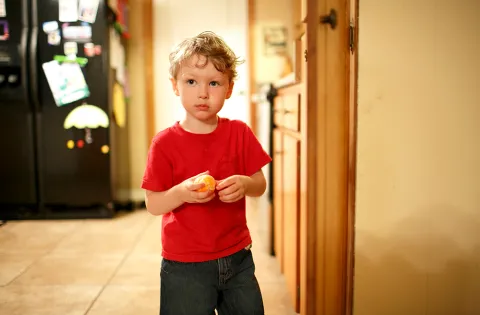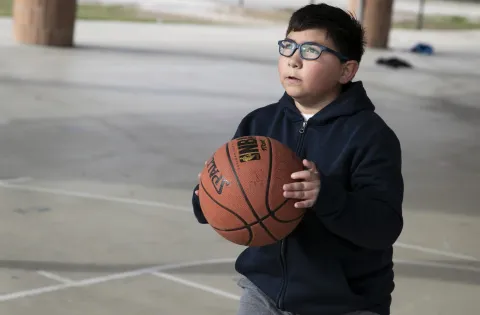Panelists discuss what promises to be a landmark year in the fight against summer hunger, thanks to the advent of Summer EBT and expanded flexibilities for rural communities.
With summer fast approaching, kids are facing what has traditionally been the hungriest time of year. This year, however, promises to be different thanks to hard fought policy wins that will help provide a comprehensive solution to the long-standing challenge of summer hunger. No Kid Hungry spoke with a panel of experts about the new summer meal programs in place to ensure kids remain nourished when school meals disappear over the summer months.
Chloe Eberhardt, senior program manager at the Center for Best Practices, moderated the panel between:
- Bryan Van Dorn, Supervisor, Michigan Department of Education Office of Nutrition Services
- Candy Biehle, Child Nutrition Director, Smithville Independent School District
- Zee Zaidoff, a SNAP recipient and community advocate, and the mother of one child, in rural Hawaii.
You can access the video recording here.
1. Summer EBT - SUN Bucks
Summer EBT, or SUN Bucks, provides every eligible child with $120 in grocery benefits for the summer months - a game changer for families struggling to stretch their grocery budget to replace the free meals their children typically get at school.
Bryan Van Dorn, who played a key role in getting Summer EBT up and running in Michigan, shared why his state felt it was imperative to opt into the program. “Even though the summer food service program that traditionally supports kids in the summertime has experienced growth over the years, it hasn’t been able to reach as many kids as we know participate in meals at school. So a permanent Summer EBT program is needed to help close the food insecurity gap for nearly 850,000 kids in just our state.”
“That additional $120 benefit that comes in for the summer will make a huge difference for families,” said Zee Zaidoff, who is raising her child in rural Hawaii and will be eligible for Summer EBT for the first time this year.
2. The Summer EBT program
The Summer EBT program is designed to serve children from all communities, ensuring that families can conveniently access essential nutrition their children need to thrive, learn, and grow during the summer and beyond. It's expected to help the families of nearly 21 million kids stretch their grocery budget and provide nutritious meals at home while kids are out of school.
Van Dorn said, “The intent of this program is to provide benefits to children from low income households during the summer months.”
He emphasized, “This program is open to all that meet the eligibility criteria regardless of race, color, national origin, sex, age, disability, citizenship or immigration status.”
Van Dorn added, “It’s definitely intended to reach as many kids as possible, and we know here in our state it will.”
3. Flexibility in Rural Communities
This year more rural communities will have the flexibility to offer non-congregate summer meal programs, where families can pick up multiple days’ worth of meals to take home or have meals delivered instead of eating them onsite. Many more school districts and community organizations are able to offer meals in the way they know works best for their community, thanks to expanded guidelines.
Candy Biehle, who is coordinating the non-congregate summer meals program for the small rural community of Smithville, Texas, shared, “The flexibility will help to assure me as a department that we are doing everything we can to feed as many children as possible.”
She added, “With that convenience, we’re going to see a lot more families take advantage of this.”
4. Free Meal Sites in Rural Communities
Rural families must often overcome multiple barriers in accessing summer meal programs, making these flexibilities all the more important in ensuring their kids stay nourished all summer long. Non-congregate free meal sites that provide multiple days’ worth of free meals are a game changer, offering families real economic relief along with summertime nutrition for their kids.
Candy Biehle knows her community well. “So it’s quite costly for these families to drive into town for a congregate meal daily.”
She added, “Parents then have to “weigh out the fact of whether it really is a free meal when it costs daily for me to get to town to provide this free meal for my child.”
Biehle shared, “So to be able to make these sites conveniently available for our rural community…it’s going to make a huge difference.”
In speaking about her own rural community in Hawaii, Zaidoff offered: “Our closest school is a 25 minute drive. A lot of families in my community, they don’t have working cars, or drivers licenses or the time to be able to drive 25 minutes each way. I work and so the time and to drive almost an hour roundtrip to pick up my child to then get to the site to then be able to eat has made it impossible. These new landmark changes are going to be absolutely huge for our community.”
5. Expanding Resources With Traditional Summer Meal Programs & New Grocery Benefits
Alongside traditional summer meal programs, new summer grocery benefits and expanded flexibilities for rural communities will help provide a comprehensive solution to the long-standing challenge of summer hunger.
Zaidoff emphasized that the programs need to work in tandem to be most effective, “I feel like it’s so important for states to understand in order to end hunger for our children specifically during the summer. It’s not one program or the other.”
She added, “It’s not an either or. Both programs are amazing and they both meet about 55-60% of the need but combined you bring non-congregate meals into rural communities where I’m not spending $5.20 in gas each way to school which is 25 minutes away, I can do that once or twice a week. I now have meals to feed my child and I now have the additional SUN Bucks to buy the things that wouldn’t be a part of the boxes and packages that I get for breakfast and lunch.”
“The two of those combined. I mean, hunger in my community in the summer when we can implement both of those things is going to drop dramatically, and in a very real way be life changing for kids. Absolutely, unequivocally the two of these in tandem are going to improve both physical and mental health for kids across the country. So exciting for me.”


